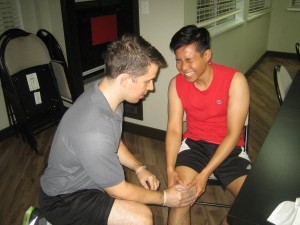Musculoskeletal trauma results in injury or dysfunction of adjacent structures and of the structures supported or enclosed by the muscular and skeletal system. If a bone is broken, the adjacent muscles cannot function properly and blood vessels as well as nerves around, between and surrounding the injured area cannot send impulses to the muscles which results in immobility and excruciating pain. Moreover, if joint surfaces do not articulate properly in their normal range of motion, neither bones or muscles can function property.
Musculoskeletal trauma is an emergency situation. Careful planning and fast implementation are always rooted in the priorities of ABCs. Unless musculoskeletal trauma is life threatening to the individual’s circulation status because of bleeding, management of musculoskeletal related injuries typically occur following the individual’s immediate stabilization. When a musculoskeletal injury impedes mobility of a joint or bone, it results in severe muscle spasms that causes excruciating pain as well as the ever growing risk of bone deformity caused by angulation of the fractured bones. These complications require careful intervention to prevent further trauma to the surrounding soft tissues, reduction in the venous and lymphatic return and control of the inflammation process.
General conservative treatment of musculoskeletal trauma
Treatment of musculoskeletal trauma and other similar injuries to the musculoskeletal system involves providing support to the injured body part or extremity until healing is complete. Support is primarily supportive and conservative unless otherwise the injuries are severe that it needs open surgery for it to properly treated. Treatment modalities typically include external application of bandages, adhesive strapping, splints or casts.
Alternative support and treatment for musculoskeletal trauma
Alternatively support may be applied in the case for severe cases of musculoskeletal trauma or injuries especially is such injuries affect long bones wherein corrective measures are applied to prevent deformity and increase the healing process much faster. At times, open surgery for profound injuries to the musculoskeletal system is the primary intervention especially when the bleeding is profuse and risk of hemorrhage is present. Secondly, when the injury is properly stabilized, support is directly applied to the injured area in the form of pins and plates. At times, traction must be strictly applied to prevent and correct deformities or shortening of the affected extremity.
Pain relief is very essential during the entire treatment process to facilitate

healing. Anti-inflammatory medications, muscle relaxants and analgesics can significantly improve and diminish the inflammatory response and help relax muscles that are at risk for spasm which can ultimately result in further injury to inflamed muscles, fractured bone and surrounding nerves.
Support and recovery of musculoskeletal trauma
Following the immediate and painful effects of the injury, treatment efforts should be focused on preventing fibrosis and atrophy or degeneration of injured muscles and joint structures respectively. Proper exercise will help prevent deformities and complications from arising. In some cases, the medications administered and the support applied permit earlier activity to promote effective healing of the affected extremity. Various forms of physical and occupational therapy may efficiently hasten the healing and recovery function following a musculoskeletal trauma.
